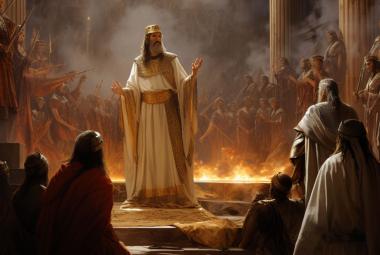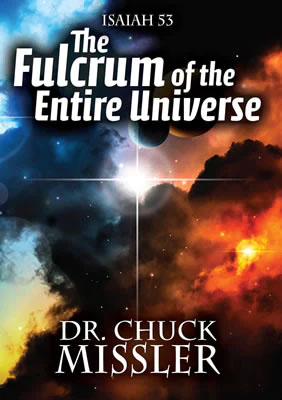Isaiah 53 describes the astonishing personal sacrifice that is the fulcrum—the pivot—of the entire cosmic drama. However, it is the personal aspect of this passage that grips our soul.
The Fulcrum of the Universe. The Pivot of All History. These sound like rather fanciful labels, don’t they? We are talking about Isaiah 53, often called the “Holy of Holies of the Old Testament.” In just 12 verses, it summarizes the entire New Testament as the clarion of the Old.
The Scope of the Passage
The surprising scope of this passage includes the entire universe. The Crucifixion of Christ involved more than just our personal redemption: it involved the entire creation. This shouldn’t surprise us: “The heavens declare the glory of God; the firmament shows His handiwork.”1
However, “the creation was subjected to entropy, not by consent, but on account of the one who subjected it so as to involve hope.”2 Paul’s epistle goes on to remind us, “Because the creation itself also shall be delivered from the bondage of corruption [entropy] into the glorious liberty of the children of God. For we know that the whole creation groaneth and travaileth in pain together until now.”3 This is a result of God’s declaration of war in Genesis 3.
So this is the Divine Conflict: We know that Satan fell and took a host of angels with him. History’s primary plot is Satan’s opposition to God.4 Amazingly, the central role in the divine conflict is humankind’s. Notice the universal language with which God’s specific covenant with Israel is recorded:
For ask now of the days that are past, which were before thee, since the day that God created man upon the earth, and ask from the one side of heaven unto the other, whether there hath been any such thing as this great thing is, or hath been heard like it?5
This covenant is unique to the Earth, exclusive to humans, and universally unprecedented. It follows that the incarnation of Jesus Christ as our Savior, delivered via Israel, is also universal. The most compelling argument for the uniqueness of terrestrial life on the Planet Earth is the Incarnation of the Creator Himself,6 who became an everlasting member of the human race.7
The Frustration of Astrobiology
Incidentally, there continues to be nothing but bad news for the “astrobiologists.” Science is the study of evidence; however, astrobiology hasn’t found any evidence to study. Despite extensive searching, there is no evidence of life beyond the Earth. (Don’t confuse wishful thinking with evidence. And don’t be surprised if astrobiology also develops the same ethics as has characterized paleontology or climatology.) This “science” has yet to demonstrate that its subject matter exists. (To even pursue its search is a denial of the conspicuous mathematical requirements for life to exist.) This isn’t science: it is priesthood.
The “Anthropic Principle” has catalogued over 140 quantifiable characteristics, each of which must fall within extremely narrow ranges for physical life to exist. There are over 400 quantifiable characteristics for advanced life to exist.8 When you recognize that many of these factors individually require a precision of less than one part per million, their composite effect constitutes a very good definition of a “miracle.”9
This Pivotal Passage
Isaiah 53 describes the astonishing personal sacrifice that is the fulcrum—the pivot—of the entire cosmic drama. This passage was so disturbing to the Ashkenazi Jews that they took it out of their Bible. (However, the Sephardic Jews kept it in theirs.) The discovery of the Dead Sea Scrolls in 1947 included a complete copy of Isaiah, and there was Chapter 53, right there in the middle.
The Book of Isaiah is in 66 chapters, in two groups: Chapters 1 though 39, and Chapters 40 through 66. Both the style and the theme are demonstrably intensified in the second section, and Isaiah 53 is precisely in the middle: 13 chapters on either side. Written in 700 B.C., Isaiah 53 is mentioned in all four gospels.10 (Those who don’t know that the same Isaiah wrote the entire book haven’t read John 12. The “same Isaiah” quotes from Isaiah 6 and Isaiah 53.11 That insight can save a student many hours of boring library research chasing erroneous speculations.)
It was this very passage that had the Ethiopian Treasurer confused on his way home, and which the Lord had Philip (supernaturally) clarify for him.12 The passage details the Crucifixion, which is particularly remarkable since this was recorded seven centuries before crucifixion was invented: the official form of execution in the Old Testament was stoning—not crucifixion.13
The rabbis say when the Messiah comes He will interpret the words, the letters… even the spaces between the letters! And there are some astonishing surprises hidden in this text.
However, it is the personal aspect of this passage that grips our soul: it is the substitutionary emphasis that is the very centroid of the Messianic achievement:
- He was born of a woman so that we could be born of God;
- He humbled Himself so that we could be lifted up;
- He became a servant so we could be made joint heirs with Him!
- He suffered rejection so that we could become His friends;
- He denied Himself so that we could freely receive all things;
- He gave Himself so that He could bless us in every way.
The Eschatological Rebuttal
The Second Coming itself is a rebuttal to any eschatological role for any life beyond the Planet Earth. (There is even a real sense in which Isaiah 53 is predictive of events which have yet to happen when Israel ultimately recognizes her Messiah.)
There are critics who will argue that we have exaggerated the scope of this passage to include the entire creation. However, there is now forthcoming a grand cosmic delusion in the offing that Jesus (and Paul) warned us about.14 So effective that if it were possible it would deceive the very elect. That specific (gigantic, elegant) lie may now be emerging on our near horizon: Why is the Vatican preparing to receive an “alien” visitor? That’s a subject for another article… Stay tuned…
Isaiah 53 is, of course, a key element of our Expositional Commentary on Isaiah, but we are also publishing our exploration of Chapter 53 as a separate two-part product: Part 1 is devotional; Part 2 focuses on it as an apologetic. (There are aspects that are demonstrably supernatural.) The Fulcrum of the Entire Universe is available on the K-House store.
[Note: I have taken liberties in this study drawing from Exo-Vaticana, the new book by Tom Horn and Cris Putnam, in which I had the privilege of a minor supportive role.]
Notes:
- Psalm 19:1ff.
- Rom 8:20 MIT.
- Rom 8:21–22 KJV.
- Gen 3:1-5; Rev 20:10.
- Deut 4:32 KJV.
- Jn 1:1–3; Col 1:16,17; Heb 1:1–2; et al.
- Jn 1:14; 1 Tim 2:5; Heb :24–25.
- Hugh Ross, Reasons to Believe.
- A basic definition in Information Science, randomness (entropy) is the absence of design: they are both antithetical to each other. To ascribe the most elegant designs to the result of randomness (entropy, or “chance”) is the definitive absurdity, and demonstrates a total lack of understanding of the very meaning of these terms. Design—or information—is often designated as “neg-entropy.” Surprisingly, many advanced string theorists are also guilty of carelessness when using these terms.
- Mt 8:17; Mk 15:28; Lk 22:37; Jn 12:37,38 and in Acts 8:32–35, Rom 10:16, and 1 Pet 2:21–25.
- Jn 12:37–41.
- Acts 8:26–39.
- Crucifixion was invented in 90 B.C. by the Persians; then widely adopted by the Romans.
- Mt 24:24; 2 Thess 2:9, 11.







